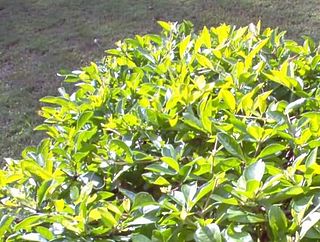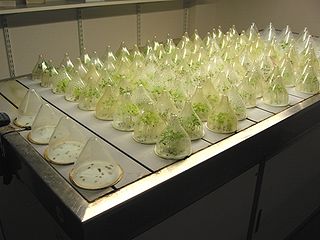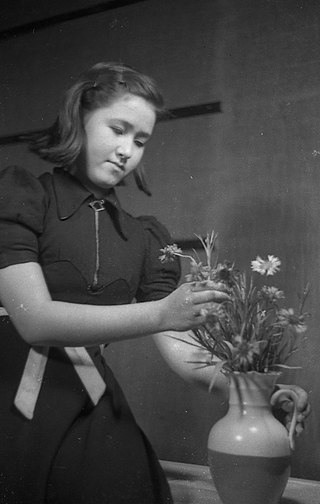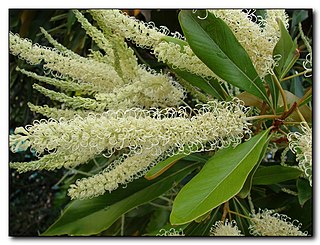Related Research Articles

A plum is a fruit of some species in Prunus subg. Prunus. Dried plums are called prunes.

Rambutan is a medium-sized tropical tree in the family Sapindaceae. The name also refers to the edible fruit produced by this tree. The rambutan is native to Southeast Asia. It is closely related to several other edible tropical fruits including the lychee, longan, pulasan and guinep.

Dimocarpus longan, commonly known as the longan and dragon's eye, is a tropical tree species that produces edible fruit. It is one of the better-known tropical members of the soapberry family Sapindaceae, to which the lychee and rambutan also belong. The fruit of the longan is similar to that of the lychee, but less aromatic in taste. It is native to tropical Asia and China.

Pruning is a horticultural, arboricultural, and silvicultural practice involving the selective removal of certain parts of a plant, such as branches, buds, or roots.

Floristry is the production, commerce, and trade in flowers. It encompasses flower care and handling, floral design and arrangement, merchandising, production, display and flower delivery. Wholesale florists sell bulk flowers and related supplies to professionals in the trade. Retail florists offer fresh flowers and related products and services to consumers. The first flower shop in the United States opened prior to 1851.

Plant physiology is a subdiscipline of botany concerned with the functioning, or physiology, of plants. Closely related fields include plant morphology, plant ecology, phytochemistry, cell biology, genetics, biophysics and molecular biology.

Matricaria chamomilla, commonly known as chamomile, German chamomile, Hungarian chamomile (kamilla), wild chamomile, blue chamomile, or scented mayweed, is an annual plant of the composite family Asteraceae. Commonly, the name M. recutita is applied to the most popular source of the herbal product chamomile, although other species are also used as chamomile. Chamomile is known mostly for its use against gastrointestinal problems; additionally, it can be used to treat irritation of the skin.

Floriculture, or flower farming, is a branch of horticulture concerned with the cultivation of flowering and ornamental plants for gardens and for floristry, comprising the floral industry. The development of new varieties by plant breeding is a major occupation of floriculturists.

Waratah (Telopea) is an Australian-endemic genus of five species of large shrubs or small trees, native to the southeastern parts of Australia. The best-known species in this genus is Telopea speciosissima, which has bright red flowers and is the New South Wales (NSW) state emblem. The waratah is a member of the family Proteaceae, flowering plants distributed in the Southern Hemisphere. The key diagnostic feature of Proteaceae is the inflorescence, which is often very large, brightly coloured and showy, consisting of many small flowers densely packed into a compact head or spike. Species of waratah boast such inflorescences ranging from 6–15 cm in diameter with a basal ring of coloured bracts. The leaves are spirally arranged, 10–20 cm long and 2–3 cm broad with entire or serrated margins. The name waratah comes from the Eora Aboriginal people, the pre-European inhabitants of the Sydney area.

Alpine plants are plants that grow in an alpine climate, which occurs at high elevation and above the tree line. There are many different plant species and taxa that grow as a plant community in these alpine tundra. These include perennial grasses, sedges, forbs, cushion plants, mosses, and lichens. Alpine plants are adapted to the harsh conditions of the alpine environment, which include low temperatures, dryness, ultraviolet radiation, wind, drought, poor nutritional soil, and a short growing season.

Floral design or flower arrangement is the art of using plant material and flowers to create an eye-catching and balanced composition or display. Evidence of refined floral design is found as far back as the culture of ancient Egypt. Floral designs, called arrangements, incorporate the five elements and seven principles of floral design.

This article presents common techniques and facts regarding the cultivation of cannabis, primarily for the production and consumption of its infructescences. Cultivation techniques for other purposes differ.

Eugenia stipitata is a fruit tree native to the Amazon Rainforest in Brazil, Colombia and Ecuador.

Verticordia grandis is a large woody shrub that occurs in Southwest Australia. The name grandis, Latin for large, is a reference to its large flowers, leaves, and height. It is well known for its large flowers, which are collected and cultivated, and given the informal name of scarlet featherflower. It was the first species of the family Myrtaceae to have been genetically modified.

Grafting or graftage is a horticultural technique whereby tissues of plants are joined so as to continue their growth together. The upper part of the combined plant is called the scion while the lower part is called the rootstock. The success of this joining requires that the vascular tissues grow together and such joining is called inosculation. The technique is most commonly used in asexual propagation of commercially grown plants for the horticultural and agricultural trades.

Rhizofiltration is a form of phytoremediation that involves filtering contaminated groundwater, surface water and wastewater through a mass of roots to remove toxic substances or excess nutrients.
This glossary of viticultural terms list some of terms and definitions involved in growing grapes for use in winemaking.

Grevillea edelfeltii, commonly known as white oak, is a tree of the family Proteaceae and is native to the rainforests of north-east Queensland in Australia and to Papua New Guinea.

Cut flowers are flowers or flower buds that have been cut from the plant bearing it. It is usually removed from the plant for decorative use. Typical uses are in vase displays, wreaths, and garlands. Many home gardeners harvest flowers from their own gardens, but there is a significant international floral industry for cut flowers. The plants cropped vary by climate, culture and the level of wealth locally. Often the plants are raised specifically for the purpose, in field or glasshouse growing conditions. Cut flowers can also be harvested from the wild.

Phytoptus avellanae is an acarine gall-mite species inducing big bud galls of up to 10 millimetres (0.39 in) across, sometimes slightly open, on the buds of hazel and on filbert. Synonyms include Phytocoptella avellanae, Eriophyes avellanae, Calycophthora avellanae, Phytoptus coryli, Phytoptus pseudogallarum, and Acarus pseudogallarum. The mites are white, about 0.3 mm long, with numerous tergites and sternites. Two forms of P. avellanae exist, a gall causer and a vagrant form that has a more complex life-cycle and does not form galls.
References
- ↑ Buchmann, Stephen (21 July 2015). The Reason for Flowers: Their History, Culture, Biology, and How They Change Our Lives. Scribner. p. 134. ISBN 9781476755540 . Retrieved 26 March 2023.
- 1 2 3 Nguyen, Toan Khac; Lim, Jin Hee (19 October 2021). "Do Eco-Friendly Floral Preservative Solutions Prolong Vase Life Better than Chemical Solutions?". Horticulturae. 7 (10). doi: 10.3390/horticulturae7100415 .
- ↑ Dole, John M.; Schnelle, Michael A. "The Care and Handling of Cut Flowers". Oklahoma State University Extension. Retrieved 26 March 2023.